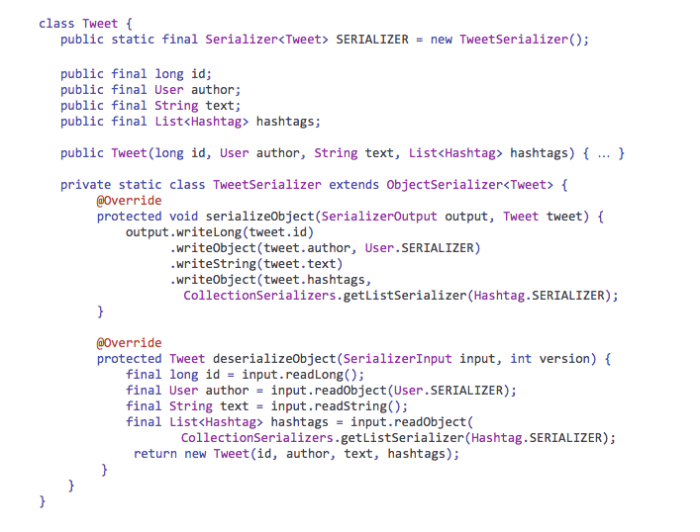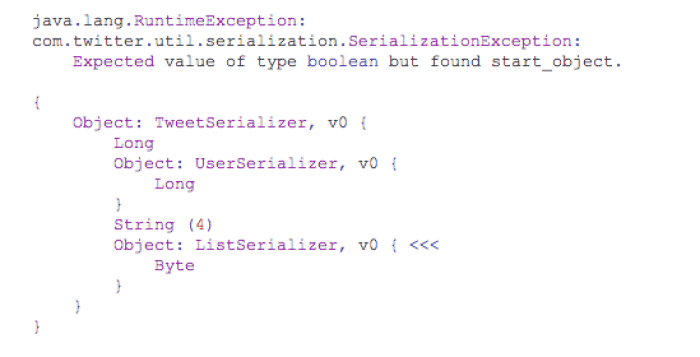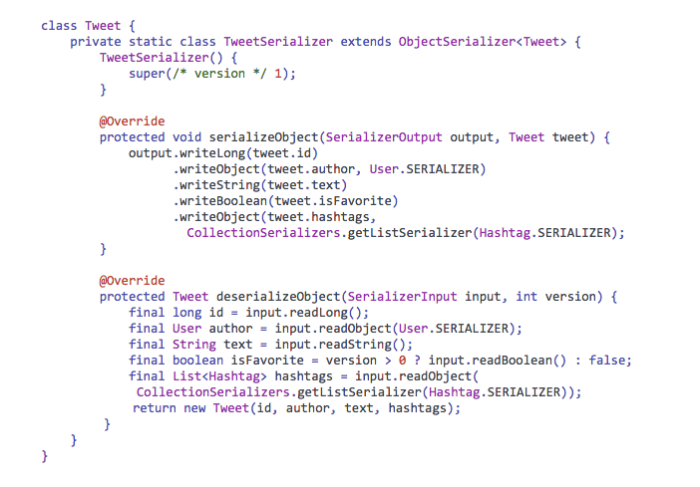Smooth timeline scrolling on the Twitter for Android app is important for the user experience, and we’re always looking for ways to improve it. With some profiling, we discovered that serializing and deserializing data to and from the database using standard Android Externalizable classes was taking around 15% of the UI thread time. Existing libraries provided little support for making iterative changes, and any changes that broke serialization caused bugs that were difficult to identify and fix without wiping the database clean.
We set out to fix this, and today we are excited to announce Serial, a new open source library for serialization.
When we started developing Serial, we identified four main pain points around the standard Android serialization libraries:
While other Java serialization libraries like Kryo and Flatbuffer attempt to solve some overlapping problems, no libraries that we found fit these needs effectively on Android. The libraries tend to target performance and backwards compatibility, but ignore debuggability and often require major changes to the existing codebase in order to adopt the framework.
Performance
We pinpointed reflection as a culprit for performance. With Externalizable, information about the class, including the class name and package, are added to the byte array when serializing the object. This allows the framework to identify which object to instantiate with the serialized data, and where to find that class in the app package structure, but it is a time consuming process.
To remove this inefficiency, Serial allows the developer to define a Serializer for each object that needs to be serialized. The Serializer can explicitly enumerate how each field should be written to and read from the serialized stream. This removes the need for reflection and dynamic lookups.
Note: The real Tweet object and other model objects in our codebase that get the most benefit from these changes are significantly larger than this example, but for simplicity this is a scaled down version.

Additionally, Serializers are stateless and can be used directly as static instances.
In a test with a large TweetEntities object, we found significant improvements in the size and average serialization and deserialization speed.

As shown in this table of results, roundtrip serialization was more than 3x faster, with serialization being almost 5x faster and deserialization about 2.5x faster (deserialization is inherently slower because of the time spent in creating a new instance of the object). The space it took to serialize this object decreased by almost 5x. These improvements will vary based on the object being serialized, but the gains are significant.
Debuggability
To improve debuggability of serialization, we took advantage of the structure of our serializer to provide meaningful and descriptive error messages. The majority of issues occur when deserialization finds an unexpected value in the input, either because something has changed since the object was serialized or there’s a bug in the serialization code. When a problem occurs, Serial provides an exception with exactly what the unexpected value was, and a dump of the structure of the serialized data to allow the developer to see where in the object the issue occurred. This helps developers easily identify and fix the issue.

Backwards compatibility
In the past, if a developer wanted to make a change to a model object, it broke serialization and usually required a database clean. To fix this problem and allow developers to make changes quickly and without additional cost, we added versioning. If a field is added or removed, you can increment the version of the Serializer. This version is written into the serialized data so that during deserialization, the version is read and can be used in the deserialization code to specify exactly what fields are expected for that version.

Additionally, we removed any reference to the class name or package from the serialized data. Unlike Android libraries, where if you moved the class or changed the name serialization would break, Serial makes it easy for developers to make changes to their codebase without these repercussions.
Flexibility
In order to make Serial easy to use, it was important that it not require significant changes to the existing model structure. Since a Serializer is defined as a standalone class that can be statically called to serialize an object, almost any model object can be serialized using this framework, even existing Android objects or objects from other imported libraries. To use a Serializer to serialize an object, you just need to create an instance of the class Serial, which allows you to transform an object to and from a byte array using the defined Serializer.


Under the hood
The Serial framework serializes objects into a compact and well structured byte stream. Each object is serialized into a byte array with an object start, the serialized object fields, and an object end. The serialized object fields are either serialized objects themselves or simple types, which consist of a type header and a value.

For the Tweet object example above, the resulting byte array would have the following structure.

The object start and end delimiters help us ensure that the serialized data is valid, and dump the structure as shown in the debuggability section above. Additionally, we can store the version number of the serialized object in the header so it’s the first thing read during deserialization and can be used to support backwards compatibility when reading the subsequent fields.
Compared to including package and class data in the serialized stream, Serial is much more efficient with its use of metadata. While these headers add some extra data, the benefits around debuggability and backwards compatibility resulting from them add more value.
Try it out
You can find all of Twitter’s Open Source projects on our Github page at https://twitter.github.io, and you can download Serial at https://github.com/twitter/serial. We're excited to continue contributing to the open source community and look forward to your feedback.
Did someone say … cookies?
X and its partners use cookies to provide you with a better, safer and
faster service and to support our business. Some cookies are necessary to use
our services, improve our services, and make sure they work properly.
Show more about your choices.